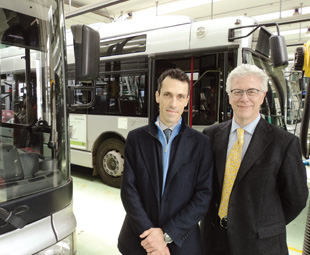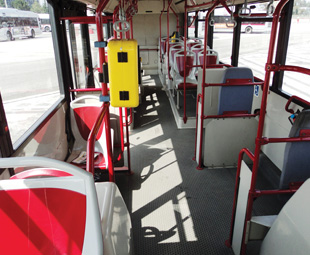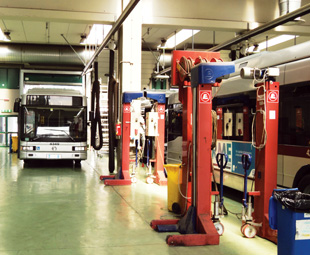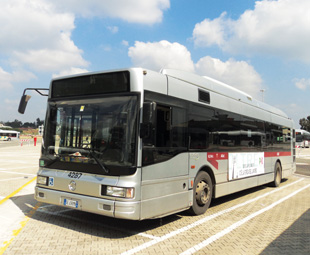Life’s a gas in Rome

A whopping 95% of the citizens of Rome have a public transport stop within 300 metres of home – and catching a bus is as easy as locating a good pasta joint or a bottle of Chianti. This is all thanks to ATAC and Irisbus Iveco, which has provided the city with a fleet of compressed natural gas (CNG) buses. CHARLEEN CLARKE travels to the Italian capital and finds that life’s a gas there – literally.
Italians are not renowned for orderliness. For being great lovers? Yes. For coming up with inspirational designs? Sure. For having oodles of passion? You can tick that box too.
But they’re just not into precise planning and those boring little details; rather than stick to a silly little schedule, they would rather devote time to listening to music and drinking great wine … Except when it comes to public transport, which works like clockwork – especially in Rome.
This is a Very Good Thing, as any visitor to the city will attest. The streets are much like a Formula One racetrack – drivers hurtle into corners at breakneck speed, often gesticulating at fellow road users at the same time. Given the fact that Rome is Italy’s largest and most populated city (its 2,7 million residents crowd into an area of 1 285,3 km²), the roads are jam packed – 24 hours a day. It’s a mad, crazy, utterly wonderful city!
 The efficient public transport system is the brainchild of ATAC, the transport agency of the municipality of Rome. ATAC stands for the Municipal Bus and Tramways Company, or Azienda Tramvie e Autobus del Comune in Italian. This privately-owned company has been carrying passengers for 100 years – back in the days of the horse-drawn omnibus, ATAC was driving Romans around their city.
The efficient public transport system is the brainchild of ATAC, the transport agency of the municipality of Rome. ATAC stands for the Municipal Bus and Tramways Company, or Azienda Tramvie e Autobus del Comune in Italian. This privately-owned company has been carrying passengers for 100 years – back in the days of the horse-drawn omnibus, ATAC was driving Romans around their city.
According to Dr Riccardo Pederzani and Giovanni Macchiaverna, from ATAC’s technical division, the company’s vehicles now travel 130 million kilometres a year. “We have 2 300 buses, 130 trams and 150 trains in our fleet,” explains Pederzani. “Our company faces an important daily challenge: to make a large metropolitan area accessible. This is the second largest city in Europe in terms of surface area and is a powerful magnet for tourists from all over the world.”
The complexity of the task at hand is mind-blowing; ATAC administers 8 260 bus stops, in excess of 350 bus routes and two underground lines with 48 stations. Metered parking is available for over 78 080 cars; it operates over 2 000 pay stations, about a third of which are powered by solar panels. There are over 1 000 loading zones, while about 23 000 free parking places are reserved for motorcycles. It also operates a more limited tram system, comprising 39 km of track and 192 stops, as well as one trolleybus line opened in 2005 (additional trolleybus lines are planned).
ATAC has well over 10 000 employees (around 1 600 technicians and maintenance personnel as well as 9 000 drivers) and its bus fleet is the one of the youngest in Italy and one of the most modern in Europe. It is an enlightened and progressive company – for instance, it allows customers to buy tickets and pay for parking using a simple SMS message. The company has also pioneered pink parking spaces for mothers of newborn babies and pregnant women.
But those are not the company’s only claims to fame. Significantly, 390 of its buses are powered by compressed natural gas (CNG) – making this the largest CNG fleet in Italy. In fact, the depot that we are visiting – Tor Pagnotta, located in the south of Rome – only houses CNG buses (230 of them to be precise). The other 160 CNG buses are located at a depot in the east of Rome, called Tor Sapenza. But the latter is not exclusively fuelled by CNG and also has 80 diesel units in its fleet.
The CNG buses were all supplied by Irisbus Iveco.
 CNG is a fossil fuel substitute for petrol, diesel, or propane/LPG. According to Wikipedia, although its combustion does produce greenhouse gases, it is a more environmentally clean alternative to those fuels, and it is much safer than other fuels in the event of a spill (natural gas is lighter than air and disperses quickly when released). CNG may also be mixed with biogas, produced from landfills or wastewater, which doesn’t increase the concentration of carbon in the atmosphere.
CNG is a fossil fuel substitute for petrol, diesel, or propane/LPG. According to Wikipedia, although its combustion does produce greenhouse gases, it is a more environmentally clean alternative to those fuels, and it is much safer than other fuels in the event of a spill (natural gas is lighter than air and disperses quickly when released). CNG may also be mixed with biogas, produced from landfills or wastewater, which doesn’t increase the concentration of carbon in the atmosphere.
CNG is made by compressing natural gas (which is mainly composed of methane) to less than 1% of the volume it occupies at standard atmospheric pressure. It is stored and distributed in hard containers at a pressure of 200 to 248 bar (2 900 to
3 600 psi), usually in cylindrical or spherical shapes.
ATAC’s buses are the CityClass 491.12.27, and the company first started acquiring these vehicles in 2005 (incidentally, around 70% of its total bus fleet hails from the Irisbus Iveco stable.) These vehicles have a level of emissions below the standard Euro-6 and also fall within the severe limits foreseen for the prospective European EEV (Enhanced Environmental Vehicle) scheme. The CityClass CNG is manufactured in the Irisbus-Iveco plant in Valle Ufita in the Italian province of Avellino.
Pederzani explains that the company went the CNG route for environmental reasons. “We have conserved 30% of our emissions,” he reveals.
But the cost of purchase is much higher. “A diesel-powered equivalent bus costs 70% of the price of the CNG version,” he tells FOCUS. Having said this, the lifecycle costs of the CNG bus are slightly lower. “We have calculated that the lifecycle cost of the CNG bus is 80% of that of the diesel derivative,” explains Macchiaverna.
 This is partially due to CNG costing less than diesel. ATAC currently pays €1,2 per litre for diesel (about R12/litre) and 70c per kilogram for CNG (about R7). However, the buses consume 10% more CNG than diesel.
This is partially due to CNG costing less than diesel. ATAC currently pays €1,2 per litre for diesel (about R12/litre) and 70c per kilogram for CNG (about R7). However, the buses consume 10% more CNG than diesel.
If the company runs a diesel and CNG bus over a 12-year period, the cost is identical – it is only after that period that the financial benefit of the CNG version begins to accrue. “Thus, from a cost point of view it is more or less the same. So this is purely an environmental decision,” explains Pederzani.
Another benefit of going the CNG route is less noise. “These buses are as quiet as those with petrol engines. The difference between diesel and CNG amounts to about six decibels, which is extremely significant,” Pederzani notes. Noise legislation in central Rome is very strict – buses cannot make more than 71 dB of noise. “When a bus is new, it is possible to achieve this goal but it is very difficult with older diesel models,” Pederzani explains.
Speaking of older buses, there are very few of these in the ATAC fleet. The company renews its fleet every 12 years and the current average age of the buses is six years. ATAC purchases between 150 and 200 new units every year.
Purchases are made after thorough testing and via a tender process. “The performance of the bus and the service of the supplier and its dealer network must be good. We use a formula to determine the outcome of the tender process – performance has a weighting of 40% while cost accounts for 60%,” Pederzani explains. “Performance” is probably a slightly confusing term; it does not only relate to the actual performance of the vehicle but also to factors such as the warranty and environmental benefits. Maintenance, lifecycle costs and the initial purchase costs are also taken into consideration before the tender is awarded.
ATAC has a varied policy when it comes to maintenance; some vehicles are maintained at the company’s in-house workshops; others by external dealers.
The CNG-powered buses come with a five-year warranty, and during this time they are maintained by an Irisbus Iveco dealer. Once the warranty has expired, maintenance moves to ATAC’s in-house workshop.
According to Macchiaverna, there are some safety considerations that come into play when running a CNG fleet. “For instance, we need to inspect the gas storage canisters every four years; they operate at pressures of 200 bar, so it’s very important to conduct regular safety tests,” he tells FOCUS.
 While on the subject of the infrastructure, this was one of the initial challenges faced by ATAC. “The reliability of the infrastructure was awful,” notes Pederzani with a rue smile. “The reliability of the compressors was terrible. In the beginning it was very difficult to find contractors to maintain them as they did not necessarily have the spare parts.” Thankfully, reliability has improved over the years – and contractors (who have gained more experience with the technology) are also more capable today.
While on the subject of the infrastructure, this was one of the initial challenges faced by ATAC. “The reliability of the infrastructure was awful,” notes Pederzani with a rue smile. “The reliability of the compressors was terrible. In the beginning it was very difficult to find contractors to maintain them as they did not necessarily have the spare parts.” Thankfully, reliability has improved over the years – and contractors (who have gained more experience with the technology) are also more capable today.
Another challenge was the speed of refuelling. “It used to take 30 to 40 minutes. But we changed pressures and rectified this problem – so now it only takes 10 to 12 minutes to put the CNG into the bus,” Pederzani explains. The buses have a capacity of 400 km a day, although they generally do 300 to 350 km each day. Their maximum speed is limited to 70 km/h, although they never actually attain this speed; the limit in Rome is 50 km/h.
So that is ATAC’s experience with CNG, thus far. Is it the way of the future? The two Italians are undecided. “A lot depends on the cost and availability. Also, we don’t know what the lifecycle costs will be; the buses have been under warranty thus far,” says Pederzani.
Macchiaverna believes that hybrids could be the solution for the future. “An electric bus is not really a solution; its range is limited and the space required for the batteries is an issue,” he points out. This is already a concern with the CNG-powered buses; ATAC’s diesel-powered buses can accommodate 105 commuters, while the CNG-powered units can only carry 90. Equivalent electric buses would carry even fewer passengers.
The problem with hybrids is cost – which Pederzani notes is 30% more than a diesel bus.
Of course, that’s the situation today. Experts all over the world tell FOCUS that this situation will change, and that the cost premium will be reduced in the not-too-distant future. Should this transpire, we imagine that ATAC would go the hybrid route.
But, irrespective of the type of transport being used, we left Rome with the distinct impression that, for the foreseeable future, public transport will be alive and well in Rome.
Published by
Focus on Transport
focusmagsa



